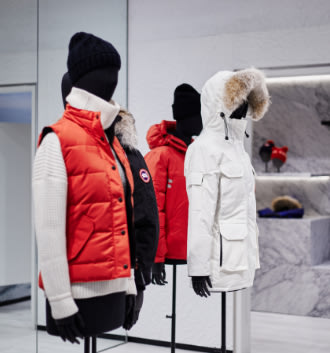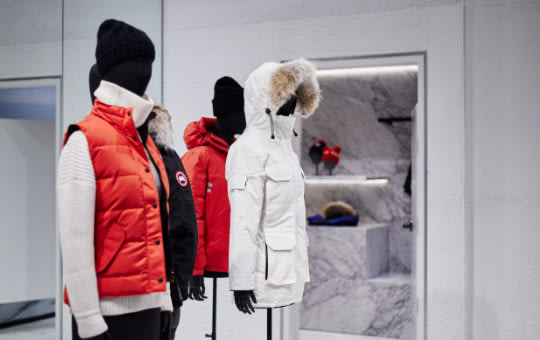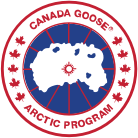Your shopping bag is empty.
- Austria (€EUR)
- Belgium (€EUR)
- Bulgaria (€EUR)
- Croatia (€EUR)
- Cyprus (€EUR)
- Czech Republic (€EUR)
- Denmark (€EUR)
- Estonia (€EUR)
- Finland (€EUR)
- France (€EUR)
- Germany (€EUR)
- Greece (€EUR)
- Greenland (€EUR)
- Hungary (€EUR)
- Iceland (€EUR)
- Ireland (€EUR)
- Italy (€EUR)
- Latvia (€EUR)
- Lithuania (€EUR)
- Luxembourg (€EUR)
- Malta (€EUR)
- Monaco (€EUR)
- Netherlands (€EUR)
- Norway (€EUR)
- Poland (€EUR)
- Portugal (€EUR)
- Romania (€EUR)
- Russia (€EUR)
- Serbia (€EUR)
- Slovakia (€EUR)
- Slovenia (€EUR)
- Spain (€EUR)
- Sweden (SEK)
- Switzerland (CHF)
- Turkey (€EUR)
- Ukraine (€EUR)
- United Kingdom (£GBP)
We are a function-first company, and authenticity is everything to Canada Goose. Since 1957 we have focused on making best-in-class products by using the highest quality materials and craftsmanship to deliver a product that performs when and where it’s needed most. In making those products, we are committed to being transparent about where and how we make our products, including the sustainable sourcing and responsible use of animal products.
We do not condone any willful mistreatment, neglect, or acts that maliciously cause animals undue suffering. Our standards for the sourcing and use of fur, down and wool reflect our commitment that materials are sourced from animals which are not subject to willful mistreatment or undue harm.
Down: A Renewable Natural Resource
We have chosen to use natural down in jackets because it is the best natural source for warmth per weight ratio.
A by-product of the poultry industry, natural down also has 18 times less of an impact on climate change than polyester fill, according to a Life Cycle Assessment (LCA) that studied the environmental impact of down versus polyester fill material. This analysis, commissioned by the International Down and Feather Bureau and conducted by Long Trail Sustainability, an independent third-party firm specializing in LCAs and sustainability reports, studied the impact of both materials in five environmental areas: human health, ecosystems, resources, cumulative energy demand and climate change. It concluded that on a per ton basis, down has 85% to 97% lower impacts than polyester in all the impact categories analyzed.
Adopting the Responsible Down Standard
In 2019, we committed to the Responsible Down Standard (RDS) and we intend to be 100% RDS-certified by 2021. This move will provide a number of advantages. The RDS aims to ensure that down and feathers come from animals that have not been subjected to unnecessary harm. Under this standard, Canada Goose will join with other brands and supply chain members to respect the Five Freedoms of the animals that provide the down and feathers in our garments.
Adopting a widely-used global textile industry standard will simplify compliance efforts for our suppliers by providing a common set of expectations and provides consumers with a tool to help them understand what is in their products. Canada Goose actively participates in the RDS Global Working Group governed by the Textile Exchange to ensure that the RDS standard continues to evolve and reflect best practices in the industry.
By the end of 2019 we had completed all of our third-party audits for compliance with the RDS at 100% of our CG owned and operated and cut-make-trim (CMT) manufacturing facilities.
Fur: Sustainable Performance
For five decades, our renowned parkas have featured wild coyote fur sourced from western Canada and the United States. Natural fur provides functionality in extreme environments and is an integral feature of authentic Arctic outerwear.
Today’s consumers want to know more about the sustainability of fur and animal welfare and demand more transparency to make informed purchasing decisions. We acknowledge this desire and are glad to provide information.
Pertaining to the sourcing of wild, western North American coyote fur, our suppliers certify that:
- They do not tolerate any willful mistreatment, neglect or malicious harm of animals.
- They only supply Canada Goose with wild fur from North American suppliers and that they never use fur from fur farms
- They only source from trappers who are regulated by state, provincial and federal standards
We pride ourselves on offering consumers with different styles, viewpoints, and tastes as much choice as possible when purchasing Canada Goose products.
In 2020, Canada Goose will launch a bold new initiative that will introduce reclaimed fur into our supply chain. We plan to begin making parkas using reclaimed fur and end the purchasing of new fur in 2022. Customers should begin to see reclaimed fur in some of our products as early as Fall of that same year.



We remain committed to the functionality and sustainability of real fur, however we are challenging ourselves to do it better, reusing what already exists. In the North, sustainability is a way of life and people there have been working with reclaimed fur for centuries. This initiative draws inspiration from that resourcefulness. We are proud to announce this commitment because we believe we must operate sustainably. It’s the right decision for our business, our customers and most importantly, our future. Learn more.
Wool: Part of our Story
As we continue to expand our product offerings, we hold true to our commitment made in 2017 and use wool from sheep without the practice of mulesing. We require that our suppliers confirm that wool in our supply chains originate from farms that do not use this practice


